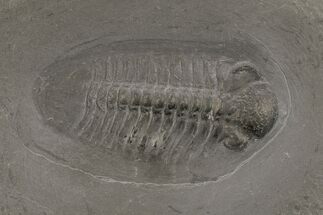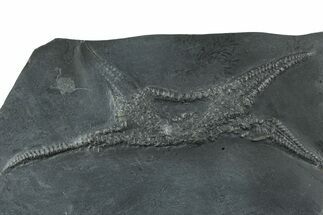This Specimen has been sold.
2.2" Pyritized Crinoid (Triacrinus) From Hunsrück Slate
This is a beautiful, pyritized crinoid of the species Triacrinus elongatum from the famous Lower Devonian Hunsrück Slate of Germany. This gorgeous crinoid specimen is 2.2" long and laying next to it is a debris field of crinoid stem pieces. Really a cool piece. Collected ceased at this location over a decade ago so the only material coming on the market is pieces from old collections such as this one.
The lower Devonian (lower Emsian) slates from Bundenback have been quarried for roofing material for centuries. Quarrying continued until the 1960s, when the competition from cheaper synthetic or imported slate resulted in production decline. The last pit closed in 2000. Mining of Hunsrück slate was important for the discovery of Paleozoic fossils. Although not rare, fossils can only be found through extensive mining of slate and time consuming preparation. Fossils are hard to see lying under the surface of dark slate. In 1970, Wilhelm Stürmer, a chemical physicist and radiologist developed a new method to examine the Hunsrück slate fossils using medium energy X-rays. The Bundenbach “Hunsruck Slate is famous for yeilding one of the most important assemblages of Paleozoic fossils, featuring 260 animal species, including many arthropods, corals, mollusks, and echinoderms - like this beutifully presented sea star.
The lower Devonian (lower Emsian) slates from Bundenback have been quarried for roofing material for centuries. Quarrying continued until the 1960s, when the competition from cheaper synthetic or imported slate resulted in production decline. The last pit closed in 2000. Mining of Hunsrück slate was important for the discovery of Paleozoic fossils. Although not rare, fossils can only be found through extensive mining of slate and time consuming preparation. Fossils are hard to see lying under the surface of dark slate. In 1970, Wilhelm Stürmer, a chemical physicist and radiologist developed a new method to examine the Hunsrück slate fossils using medium energy X-rays. The Bundenbach “Hunsruck Slate is famous for yeilding one of the most important assemblages of Paleozoic fossils, featuring 260 animal species, including many arthropods, corals, mollusks, and echinoderms - like this beutifully presented sea star.
SPECIES
Triacrinus elongatum
LOCATION
Bundenbach, Germany
FORMATION
Hunsrück Slate
SIZE
2.2" long, Matrix 5.7x4.1"
CATEGORY
SUB CATEGORY
ITEM
#17539
We guarantee the authenticity of all of our specimens.
 Reviews
Reviews











